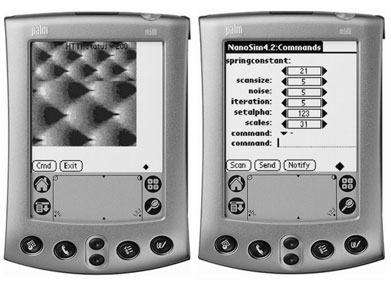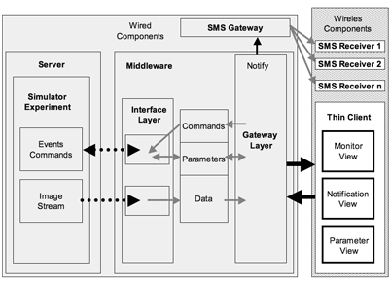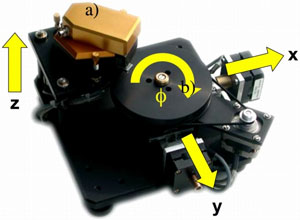
This issue in pdf Archive: |
|
|||||||
Monitoring and Controlling Scientific Experiments: Anywhere - Anytimeby Christian Wattinger, Peter Fornaro, Martin Guggisberg, Tibor Gyalog, and Helmar Burkhart Monitoring and controlling a scientific experiment from your mobile device anywhere and anytime - this is the goal of the MURCI (Mobile Universal Remote Control Interface) project at the Department of Computer Science of the University of Basel. Mobile devices, such as mobile phones and PDAs, include always-on wireless networking, persistent memory, computational capabilities and enhanced user interfaces, and allow the uploading of small programs that exploit these abilities. This opens the concept of remote, real-time control of experiments. As mobile devices gain more and better technical features, their role as location-independent networking tools becomes more significant. Only a few months ago the sole use of a mobile phone was voice communication, with cumbersome procedures and slow and expensive connections making data transmission unfeasible. This situation has changed significantly with the introduction of GPRS (General Packet Radio System) networks. In the meantime, PDAs have also matured, now offering Bluetooth connectivity and the ability to be readily programmed, eg using Java. Despite these positive advancements, today's mobile devices still suffer from slow connection speed, small screen sizes and limited memory and overall performance. Both these new capabilities and restrictions make it advisable to use a 'thin client'-based model for developing mobile applications. A 'thin client' is a lightweight program running on a mobile device, which makes use of networking capabilities as well as the display and user interface. All resource-intensive program parts are run on a server computer which is accessed by the mobile device. A project of the newly founded Mobile Technologies Group at the Department of Computer Science of the University of Basel is deploying this paradigm in the realisation of a system framework for remote experimentation. The notion of an experiment in this context has a broader meaning, which can include physical experiments, simulations, and long-term calculations in high-performance computer systems. Our first demonstrator site, 'wireless Nano-World', implements the monitoring and control of an Atomic Force Microscope (AFM) simulator. An AFM is an instrument used in the nanosciences to explore surfaces at the nanometre scale, such that single atoms and molecules become observable and can even be manipulated. The simulator has been developed as part of the Virtual Campus Switzerland project 'Nano-World' and is used in teaching, learning, and training exercises. This is necessary because real AFMs are complex and expensive instruments, and very few of them are readily accessible to students. The use of simulators for training is popular with students, and being hands-on, is an effective and motivational learning tool. The use of the mobile thin-client model to monitor and control a real experiment or simulation offers many advantages to the experimentalist. One advantage of having a tool to remotely observe and steer an ongoing experiment in a laboratory is the ability to control long-time measurement from the office, home or even while travelling, eg on a train. Another big advantage is the ability to easily notify collaborators or an administrator. This notification mechanism can be triggered actively or automatically by the remote-controlled system itself, eg in the case of a malfunction or after a self-test. This message can alert a human supervisor or trigger another process on a receiving machine. Technically, the model used is a layered architecture. The experiment or simulation defines the input/output ports to which a middleware layer is linked. The middleware processes the data and translates it so as to be usable by the respective end-points. The mobile thin client presents the arriving data and accepts control commands for the experiment. The thin client itself has three basic components:
The thin client connects to the real-world experiment or simulation via a middleware layer, which mediates between the experiment and thin client as seen in Figure 2. The middleware in the second layer must present measurement data to the wireless client in a bandwidth- and transmission-cost-saving and standardised manner, while accepting continuous data streams from an experiment. Commands from the client on the other hand must be converted by the middleware to make them understandable by the experiment/simulator. This middleware layer is advantageously implemented as a Java servlet to easily introduce scalability for many simultaneous clients, as well as optional authentication elements. At the moment the middleware is still Common-Gateway-Interface-(CGI)-based and leaves much to be desired in terms of performance and reliability. As feedback from the research community has been very positive, we want to rewrite and extend the prototype towards an operational mobile client to be used by researchers of the nanoscience competence centre. Thus the next goal is a real remote-controlled Atomic Force Microscope with a controllable sample table (Figure 3). This microscope allows standard sample positions to be defined, which can then be remotely reselected with micrometre precision. In this way, the instrument can be shared according to a schedule or notification by a number of researchers, each of whom can independently access his or her samples.
With regular self-tests and corresponding alerts to inform users in case of problems, it will be possible to run such research instruments in an administrated mode, where human interaction is only necessary for the setup of the probe and sample and in case of a failure notification. Valuable measurement time is therefore efficiently shared between research groups. Please contact: |
|||||||




